What's in the box this week
~~~~~~~~~~~~~~~~~~~~~~~~~~~~~~~~~~~~~~~~~~~~~~~~
Content differences between Family and
Small shares are in red; items with a
"+" in one size share are more in quantity than in the other. For any items
not from our farm, we will identify the source in parentheses. Occasionally content will differ
from this list (typically we make a substitution), but we do our best to
give you an accurate projection.
Family Share
Apples (see "About the apples", below)
Artichokes (Swanton Berry Farm)
Arugula
Mizuna
Baby mei qing choi
Tatsoi
Red beets
Broccoli (Lakeside)
Chard
Collard greens
Green garlic +
Leeks +
Bagged baby red/green oakleaf lettuce
French breakfast radishes
Red radishes
Strawberries (maybe! depends on the rain situation)
Small Share
Apples (see "About the apples", below)
Arugula
Mizuna
Tatsoi
Broccoli + (Lakeside)
Carrots
Chard
Green garlic
Leeks
Romaine lettuce (Lakeside)
Red radishes
Strawberries (maybe! depends on the rain situation)
Bread Option
This week's bread will be 3-seed whole wheat
Extra Fruit and Fruit "Bounty" Options
Remember, these options don't begin until May or later.
|
You gotta love it - Timing and Lucky Breaks
~~~~~~~~~~~~~~~~~~~~~~~~~~~~~~~~~~~~~~~~~~~~~~~~ I am always amazed how all of us who live and work here tune in and juggle the many tasks the farm calls upon us to accomplish every day. Last week was a perfect example, when we all turned into a family of multi-tasking agrarian acrobats: juggling unpredictable weather conditions, and hosting 24 visiting Montessori high-schoolers from Cincinnati while organizing the start of our 15th CSA season. Each of us wears many hats, whether in the field, education garden, office, greenhouse, packing barn, at Farmer's Markets, on the tractors, or working with the animals. I am certain that the creativity, flexibility, dedication, patience and skill required from each one of us is only possible because we love the work we do.
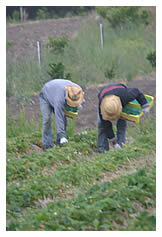 Strawberries, which are the most vulnerable to water damage when they are ripe, had to get picked first thing on Tuesday morning before the rain moved in. Luckily the rain didn't materialize until about 9am; by that time, most of the ripe berries were picked, packed and safely stored in the cooler. As a result everyone got a basket with their first share of the season.
In addition to all the harvesting for the Farmer's Markets and CSA shares, we also worked late on Wednesday to finish planting an acre of asparagus before the rain fell later that night. Luckily the rain amounts were less than expected, which allowed us to also plant Rhubarb with the high-schoolers on Thursday morning. I am grateful that we had the help of all the students, especially when we were running against the clock trying to plant a large field of potatoes on Friday morning, just hours before more rain moved in early Friday afternoon (see pictures in Jessica's Education Programs Update, below).
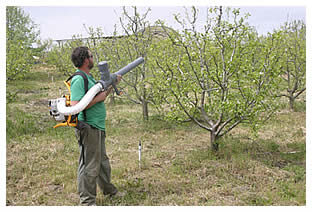 Every year in early Spring when our Warren Pear orchard starts blooming, some of us turn into human pollinators. For some still mysterious reason, this particular pear variety has poor fruit set when left to its own devices, so to ensure a reasonable harvest, every year we engage in this cumbersome courtship between us and the pears, which means dusting the flowers with pollen at least three times over the course of their bloom period. Successful pollination is largely dependent on the weather. Luckily, the week before last was sunny and we were able to make two applications, and then last week we had enough of a break between rain events to apply a third and final dusting of pollen. I'll keep you posted as to what the fruit set ended up being. (Above right, Jeff pollinates some pear trees.)
Another practice where timing is critical is weeding. It's the most critical with carrots, where if we miss the opportunity to eliminate weeds before the carrot seeds germinate we lose the crop. Carrots are sown directly into the ground and take approximately 8-14 days to germinate. Typically weed seeds will germinate before the carrots will, which means if the weed seedlings are not removed before the carrots emerge, the tiny carrot seedlings will be smothered before they have a chance to develop into carrots. Weeding carrots by hand is prohibitively time consuming. I was relieved when the seedbed where the carrots were sown into got "weed-flamed" just before this weekend's rains, since all the carrots had germinated when I checked this morning.
In anticipation of our next plantings of cucumbers and tomatoes, it was also important all the field and soil preparations were finished before the soil got too wet again. Anticipating more rain, the best preparation is to hill up the soil - this is known as listing - so that when it rains the water will drain away, reducing compaction and the time one has to wait before being able to plant again. (Below, Juan prepares the big Kubota tractor to cover the potatoes; inset: Juanillo listing a bed with our small tractor.) 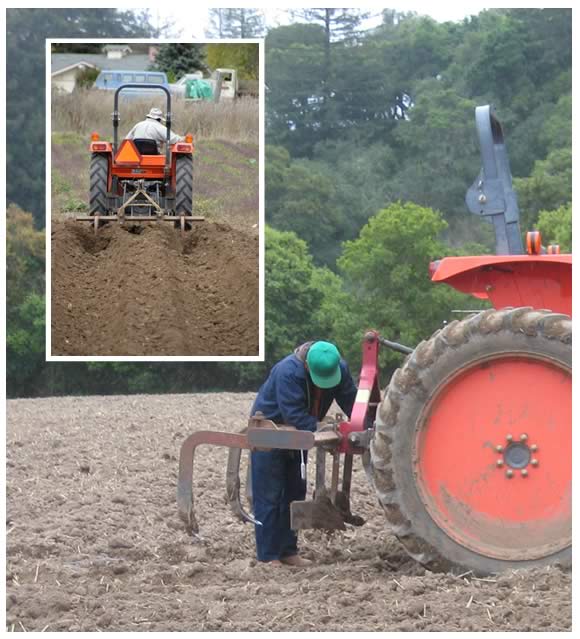
This may all sound pretty straightforward, but as a grower one needs to time things just right and keep a fine eye to details; the soil moisture has to be good (too wet and you get clods to last the summer), the shanks and shovels on the tractors have to be digging at the right depth (not too deep, not too shallow), and all the while you have to run the tractor in straight rows.
It's easy to romanticize farming when looking at the beauty of an apple blossom, however behind the beauty of every flower, sprouting seedling, tender shoot, root or fruit is a team of dedicated, hard working, skilled caretakers and stewards. - Tom
|
About the apples
~~~~~~~~~~~~~~~~~~~~~~~~~~~~~~~~~~~~~~~~~~~~~~~~ Some of you have had questions and comments about the apples, and so we wanted to provide you a bit more information, so that you understand the situation. The apples you are receiving in your shares now were harvested last fall, when they were at their peak of ripeness and flavor. For each variety of apples, we pick all the fruit at once (some varieties ripen in early-fall, others late-fall), and then store them in our big coolers and bring them out in small batches over time to put in CSA shares and send to farmers markets. This system is not unique to our farm but rather is common practice with any apple grower. Apples are the cabbage of the fruit world, in that they can store well for long periods of time when chilled properly. (We could never do this with apricots or strawberries!) But like any fruit or vegetable, they don't last indefinitely, and quality will diminish over time. So the apples you are receiving now, although not at their crisp and succulent best like when they were first picked, are still good to eat and cook with. When we prepare to pack your CSA boxes each week, we pull bins of apples out of cold storage and sort them, separating out any that are bruised or starting to go bad, in order to give you the best ones we have. The trouble is, we are sorting through thousands of apples at a time, and, being only human, sometimes a bruised or damaged apple will sneak past an otherwise watchful eye and end up in your box. There is also a phenomenon called "bitter pit" which is when an apple starts to go bad from the inside out. 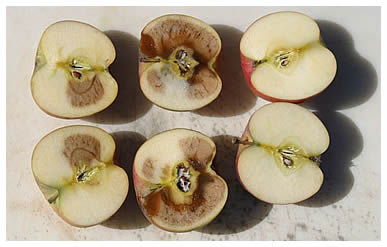 The outside looks perfectly fine. So when we are sorting apples, these may come through and end up in your box and we would not notice - which is as frustrating for us as it is for you! But we are constantly testing batches of apples to watch for this, and so if we saw too much of it, we would stop giving you apples, however it is not all that common. Because our apples are near the end of their "shelf life", we are giving them to you in greater quantity, so that even if you should receive an occasional bruised or bad apple, you will still have plenty of other good ones! We hope you understand. The only other option is to cease giving anyone apples at all, and we feel that since they are mostly still good, that would be a waste. We want to give you the benefit of the additional fruit in your shares. We do, however, recommend keeping your apples refrigerated and eating them within a week or so; they will not keep out on a basket on your countertop the way a freshly-picked apple would in the fall.
|
Telling Small and Family Shares apart
~~~~~~~~~~~~~~~~~~~~~~~~~~~~~~~~~~~~~~~~~~~~~~~~ If there are no signs telling you which are which, you can always go by the color of the box: the Family boxes are white on all sides; the Small boxes are brown (with some white and blue printing on them). In this photo, the small shares are on the left, and there's a Family Share on the right. Note the binder: remember, you always want to look for that binder first, and see what's listed next to your name for what to take! 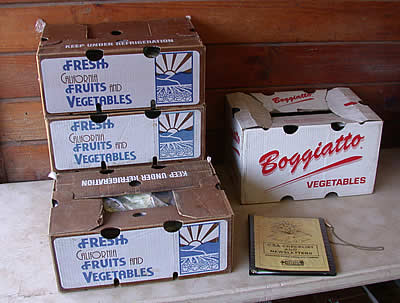
|
Where is my "Extra" or "Bounty" fruit?
~~~~~~~~~~~~~~~~~~~~~~~~~~~~~~~~~~~~~~~~~~~~~~~~
For our eager fruit-arians out there, you will need to be patient a few more weeks yet. Remember, our fruit options - both 'Extra Fruit' and 'Fruit "Bounty"' - don't begin until May (the strawberries you're receiving right now are part of your Family or Small share). Usually "Extra Fruit" starts in early May, and then "Bounty" kicks in in mid-to-late May.
What's the difference between the two fruit options again?
Pay attention. There will be a test at the end of this newsletter. (Kidding!) ;-)
Extra Fruit = 29 contiguous weeks of fruit starting in May and running through the end of the season. It will be a generous quantity of fruit to supplement that which comes with your weekly share. This fruit option contains all the different fruit we grow, as it ripens, so at first it will be simply additional strawberries, but then as summer progresses you will see our other berries (blackberries and raspberries), and stone fruits (plums and apricots), and then in the fall, our delicious Warren pears and crispy fresh-picked apples in several varieties.
Fruit "Bounty" = 15 floating weeks of fruit starting sometime in late May. This option can contain any of the fruit in the Extra Fruit option; it all depends on what we have a 'bounty' of! We created this option so that more of you could receive additional fruit. Although we don't have enough fruit to promise everyone 'extra' all season, there are definitely times when we have a 'flush' of something, so to take advantage of that (and also to provide more members with supplemental fruit), we came up with this option. You will not know until you receive this newsletter whether you will have "bounty" fruit in a particular week.
|
Education Programs Update
~~~~~~~~~~~~~~~~~~~~~~~~~~~~~~~~~~~~~~~~~~~~~~~~ Last week the farm welcomed, educated, and integrated 24 juniors
and seniors from Clark Montessori High School, a group which came all the way from Cincinnati, Ohio. Fortunately the week turned out to be a lot
less rainy than "they" were predicting, so while the group did get wet in the evenings, we enjoyed drier and
productive days. As with
everything on the farm we all had to stay flexible, so that when the time was
right and the fields were ready, we could seize the opportunity.
On their first day we had planned a long stroll
around the farm designed to introduce them to both the space and the
sustainable agriculture concepts they would implement with their own hands in
the coming days. However, the
asparagus field was dry, and ready to be plowed and planted so we directed our
introductory walk to the asparagus field.
When we arrived, our plans changed again, because the tractor Juan was
using to dig the trenches for the plants, was slipping through the damp and
sandy soil. In order to get
trenches dug into that field he would have to go back for the crawler tractor. So while we did not get to plant
asparagus there and then, we found ourselves in a great spot to introduce
Farmer Tom and talk about soil quality, then move through the lower fields and
to the new barn, where we caught the team packing the very first CSA shares. (Not to worry, those of you who plan to
be CSA members long enough to enjoy that exciting new perennial crop we were
supposed to plant -- David and a
crew got that field planted later that afternoon, and we should be enjoying a
growing asparagus crop in the spring seasons to come.)
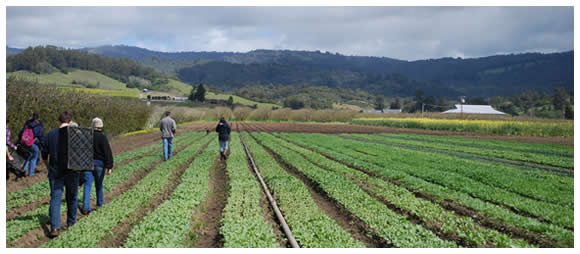
Such flexibility, as demonstrated in that first afternoon
with the high schoolers, has become my mantra while educating at Live Earth Farm. I have learned to plan blocks of
possible activities, rather than detailed schedules because in order to
participate in the work happening on the farm you have to account for many factors,
especially the weather.
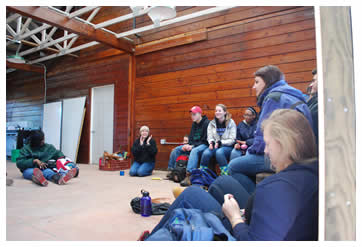 Clark High School's visit progressed through rainy evenings
and mostly dry days. They held at
least one camp fire, and luckily had a dry place to hang out, as they were the
inaugural group to use our new breezeway education space in our old "upper barn". We did a lot of work in the educational garden,
getting several beds ready for planting, building new wattle walls, planting
flowers, building arbors, and starting the long awaited herb spiral. Those who were interested helped the farm's apprentices (Taylor, Molly, David, Jeff) with animal chores. Clark and
Wavecrest [our local Montessori with a weekly class on the farm] worked together to plant another exciting perennial crop - rhubarb - into very different soil from that of the asparagus field, on a nearby slope. And we all went down to the Santa Cruz
Farmer's market to learn about how some of our produce makes it out into the
world, and to see the kind of community Live Earth Farm has come to thrive in.
All of the work and learning culminated in a fine day of
planting potatoes into damp soil, just before Friday's afternoon rain, then
preparing a pizza party mostly under cover of the breezeway. We planted about an acre of Russian
Banana and Yellow Finn potatoes on the very back of the property (see pictures, below), learning about
the Irish Potato Famine and the thousands of varieties of potatoes grown in the
Andes as we went. Then we spent
the afternoon building a fire, making dough, chopping kale and leeks, milking
the goats and making cheese, squeezing lemons, chopping strawberries, and
whipping cream. And this is where
I send a big shout out to the LEF apprentices who helped a lot throughout the week,
and were integral to our Friday afternoon as they lead groups in these final
tasks.
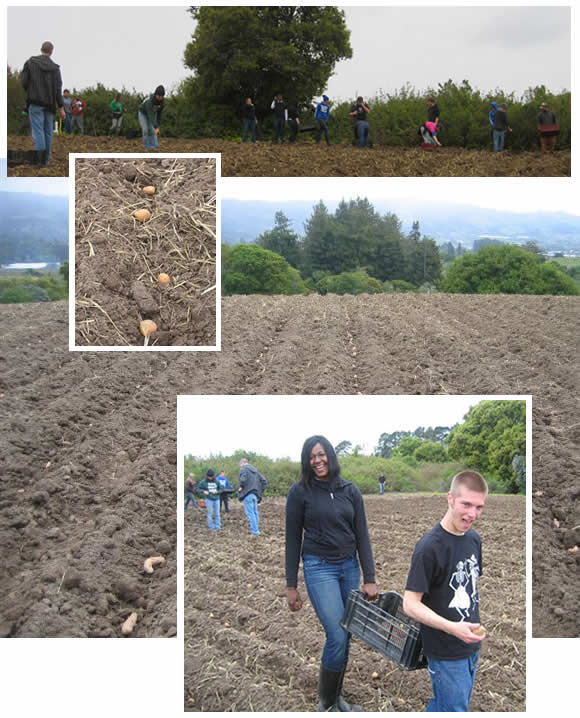
The pizza party was sweet and felt well earned. Once again, in the final minutes of our
closing circle, I was impressed to hear all of the things the Clark Montessori
High School students learned during those few days on the farm. Closing circles are illuminating
because the students get a chance to express what mattered to them in all of
the experiences we provided for them during their stay. They digested a lot of information and
experiences and will take a little bit of Live Earth Farm back to Cincinnati
with them. For leaving a bit of
Cincinnati behind, thank you Clark Montessori High School.
Jessica Ridgeway Director, Live Earth Farm Discovery Program
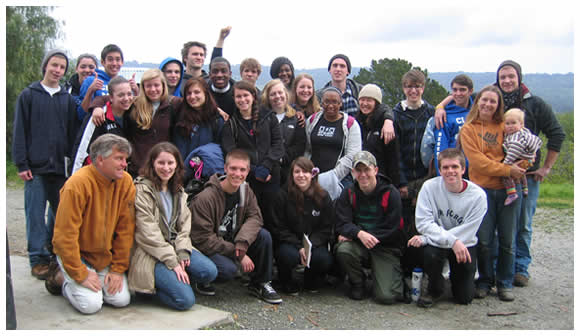 [Farmer Tom at lower left, orange jacket; Jessica in orange sweatshirt, at right, holding daughter Ophelia]
|
Understanding Gluten Sensitivity - lecture and cooking class at LEF
~~~~~~~~~~~~~~~~~~~~~~~~~~~~~~~~~~~~~~~~~~~~~~~~ 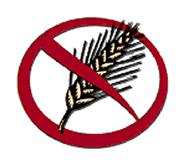 Let's demystify the
subject of gluten sensitivity. This condition afflicts many more people
than commonly thought, with affects in body systems beyond the G.I.
tract. Undiagnosed gluten sensitivity is the
root cause of many cancers, autoimmune and neurological disorders,
chronic pain
syndrome, psychiatric and other brain disorders. The lecture will cover
the different types of gluten
sensitivity, its various manifestations, testing options, and healing.
We will make and share a delicious, healthful
gluten-free meal , and learn how to make the transition to eating a
gluten-free diet. Recipes, resources lists, and meal plans will be
provided.
This workshop will be lead
by Karen Haralson, M.A., N.C and Rebecca Mastoris, N.C., natural chef
instructor at Bauman College
Date: May 1, 2010
Time: 11-4
Place: Live Earth Farm Barn Kitchen
Cost: $65
Contact: Karen at 831-335-3245 or ktese@cruzio.com
|
Notes from Debbie's Kitchen
~~~~~~~~~~~~~~~~~~~~~~~~~~~~~~~~~~~~~~~~~~~~~~~~
Click here to go to the recipe database.
I often like to share cooking ideas submitted by members here. Everyone does things a little differently, and so it is nice to see how others prepare meals from their CSA box; it's interesting to see other perspectives. So many times you learn something new - I know I do! Anyway, I'd like to start this week's recipe section with a contribution from Lori Clemmons. Oh, and for people new this year, if you ever see comments inserted below in square brackets [like this], that is me, adding my two cents! - Debbie
Lori Clemmons' advice for new CSA eaters
First, if you've never been a CSA member before, it can be really overwhelming. My
family started mid-way through last season, so I know! So I thought I'd share a
couple of ideas that helped us through our first few months.
1. There may be lots of unfamiliar veggies in your box. The first
few weeks just cook with what's familiar till you're comfortable with it. After
that, just pick one new veggie a week to try. Don't feel bad giving some to the
neighbors, composting, or feeding to the chickens. It takes a while to get the
hang of it. Even if you don't use everything, you're probably still eating
healthier than you were before. [When I was a new CSA member - 13 or 14 years ago - I regularly had friends over for dinner to help me use up my veggies before the next week's delivery! - Debbie]
2. Don't stress. Eventually you'll figure out some new favorite
recipes to use - hang in there!
3. Find a few recipes that can be really versatile and use lots
of ingredients from the box. One of our standbys has become Asian Beef and
Greens (see below).
4. Don't be afraid to try new things - after all, you were just
going to throw those unfamiliar veggies away, so why not experiment?
5. Write down your experiments as you go. There's nothing worse
than making the perfect dish and not being able to remember how much of what
went into it.
6. Have a sense of humor - it helps when something really flops!
7. Use Deb's recipe database on the LEF website - it's amazing!
Take some time to skim through what's in there. Check back often for more
inspiration.
8. Don't limit yourself to traditional mealtimes. You'd be amazed
what you can have for breakfast. One of our favorite breakfast foods has become
bacon and Brussels sprouts [Lori provided her recipe for this, but we won't be getting them again 'til next winter so I have left it off for now]. Before this year, we'd never even tried Brussels sprouts - now the kids fight over them.
9. Let the kids help as much as possible. It makes the new foods
not as scary.
10. Send your successes to Deb to include in future newsletters.
We're all continually looking for new recipes!
Asian Beef and Greens
(adapted from Traci Townsend's Classic Beef or chicken Veggie Stir-fry)
2 lbs. London Broil (or equivalent)
6 oz toasted sesame oil (divided)
1 oz white wine vinegar
2 oz soy sauce
Slice beef and cut into bite-sized pieces. Marinade several
hours in 3 oz toasted sesame oil, the white wine vinegar, and the soy sauce.
Drain off marinade. Fry beef in 3 oz toasted sesame oil. Add
in garlic, ginger (lots!), onions, and/or leeks and fry till tender.
Thinly slice lots of greens [We're getting lots of Asian greens this week, so timing is perfect!]. I've used Napa cabbage, turnip
tops, beet tops, bok choy, kale, dandelion greens, mystery greens from the
Asian market - just about anything (except spinach - too strong for this dish).
I usually use about three or four bunches of whatever greens I have on hand.
Add the rest of the marinade and the greens to the beef and fry until tender.
Member Anna S. sent me this recipe
last month, when we were getting lots of leeks. Since we're still getting them,
thought it'd be a good time to include this one.
French Leek and Potato Soup
1.5 lbs of russet potatoes [I'll use any potato; doesn't have to be russets]
3 large leeks
3 quarts water
1 tbsp. sea salt
1 tbsp. ground white pepper
2 tbsp. butter
1/3 C heavy cream
Minced chives (should be producing in your kitchen garden by now)
Bring the water and salt to a boil.
Score potatoes around the middle and drop into the boiling water for 15 minutes. Remove potatoes from the boiling water, drop into a bowl of ice water and pull off the peels.* Slice the potatoes thinly.
While potatoes are boiling, above, clean and slice thinly the white and tender green parts of the
leeks.
Take the potato skins, remaining green leek leaves and root ends from the leeks [be sure there's no dirt!] as well a few handfuls of the veggie scraps that Debbie suggested you store in the freezer [Basic Found Vegetable Stock] and roll them up in a cheese cloth and tie the ends.
Add this to the water along with the potatoes, leeks and white pepper and simmer for 45 minutes.
Remove from heat and strain solids from liquid (reserve both solids and liquid). Return liquid to pot. Squeeze liquid out of cheesecloth package into pot. Compost contents of cheesecloth package and discard cheesecloth. Correct seasonings of liquid in pot.
Add the butter and cream to the solids and whip as though you were making mashed potatoes. When nice and smooth, return to pot and stir to combine with the liquid.
Can be refrigerated until ready for use. Bring to a simmer before serving and top with minced chives and optional cracked pepper.
Makes 1 1/2 quarts of soup for 2-4 servings.
*[this is alternative technique for peeling potatoes; you can always use a peeler if you want to. Anna sent this goofy little you-tube video of Dawn Wells (aka "MaryAnn" from the old TV show "Gilligan's Island") demonstrating this peeling technique. I don't know if it will work on other kinds of potatoes, but you can always experiment!]
Lastly, speaking as Lori did of 'standby' recipes - i.e. those ones you go back to again and again, this is one I make often when I receive broccoli. I ran this originally in the farm newsletter back in 1999.
Spicy Sardine & Broccoli Pasta
Modified slightly from a salad recipe out of Jane Brody's Good
Food
Book, this recipe packs a punch and my husband and I just love it! Jane
sez its loaded w/calcium & vitamin A, too. - Debbie
(serves 2-4)
1 bunch broccoli, cut in bite-size pieces
1 tin smoked sardines in olive oil
penne pasta
2 tbsp. soy sauce
1 tbsp. oil from tinned sardines
1 tbsp. sugar
1/4 tsp. hot red pepper flakes
1 clove garlic, crushed
In a large pot of boiling salted water, boil pasta 'til done,
adding
broccoli during last 4 minutes of cooking time so they'll be done at the
same time. [Alternatively, you can boil your pasta and steam the broccoli separately; as of late, I've taken to doing this, as the broccoli florets tend to hold water. But it is really fine either way.] Meanwhile, combine soy sauce, oil, sugar, pepper flakes and
garlic in a small bowl. Drain pasta/broccoli, dump in a bowl, break up
sardines into same bowl, add dressing and toss. Serve hot.
[Also works well cold and left-over the next day, like a pasta salad!]
|
|
2010 CALENDAR
~~~~~~~~~~~~~~~~~~~~~~~~~~~~~~~~~~~~~~~~~~~~~~~~
Visit our calendar page on our website for photos and videos of past events if you would like to get the flavor of what it is like visiting the farm!
Live Earth Farm Discovery Program for WEE ONES
3rd Tuesday of every month, 10:30am - Noon
(free for children 0 - 3 yrs; $10 - $15 per adult)
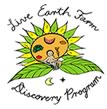 Mothers, fathers, grandparents, caretakers of any kind... bring the babe in your arms to experience the diversity of our beautiful organic farm here in Watsonville. We will use our five senses to get to know the natural world around us. The farm is home to over 50 different fruits and vegetables, chicks, chickens, goats, piglets, and the many wild members of the Pajaro watershed. Mothers, fathers, grandparents, caretakers of any kind... bring the babe in your arms to experience the diversity of our beautiful organic farm here in Watsonville. We will use our five senses to get to know the natural world around us. The farm is home to over 50 different fruits and vegetables, chicks, chickens, goats, piglets, and the many wild members of the Pajaro watershed.
For more information, contact Jessica at the LEFDP office: (831) 728-2032 or email her at lefeducation@baymoon.com.

Happy Girl Kitchen's 2010 Workshop Schedule at LEF
(all workshops are from 10am to 3pm and include an organic lunch, as well as take-home items from what is made that day!)
March 6 (Saturday) - Fermentation (sauerkraut, kimchee and kombucha)
April 10 (Saturday) - Cheese and kefir
June 6 (Sunday) - Cherries and spring berries
July 10 (Saturday) - Apricots, strawberries and blackberries
September 12 (Sunday) - Heirloom tomatoes
October 2 (Saturday) - Pickles
Contact Jordan if you have any questions
jordan@happygirlkitchen.com
http://www.happygirlkitchen.com
Community Farm Days Schedule
(All Community Farm Days are Saturdays unless otherwise noted.)
March 20 - Sheep to Shawl
May 29 - Three sisters planting in the field! Help sow pumpkins, corn, and beans
June 19 - Summer Solstice Celebration and Strawberry U-pick
July 3 - Apricot and Strawberry U-pick
July 12 thru 16 - Summer Celebration Art on the Farm Day Camp!
Aug 28 - Totally tomatoes. From farm to fork, cooking with tomatoes and making farm-fresh cheese. Also U-pick raspberry and tomato day!
Sept 25 - LEFDP Second Annual Fundraiser
Oct 23 - Harvest Celebration and Apple U-pick
Understanding Gluten Sensitivity - Lecture and Cooking Class
Saturday May 1st, 11am - 4pm, on the farm (in the farm barn kitchen)
click here for more info
|
|